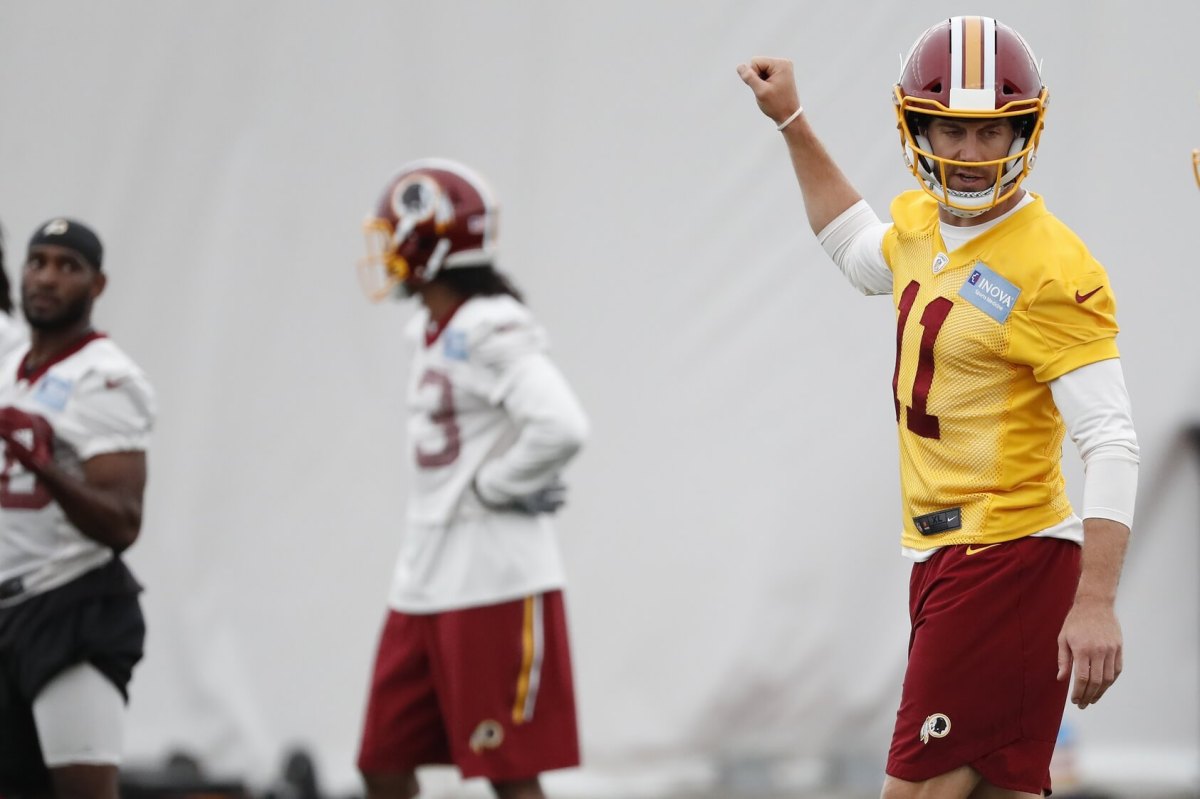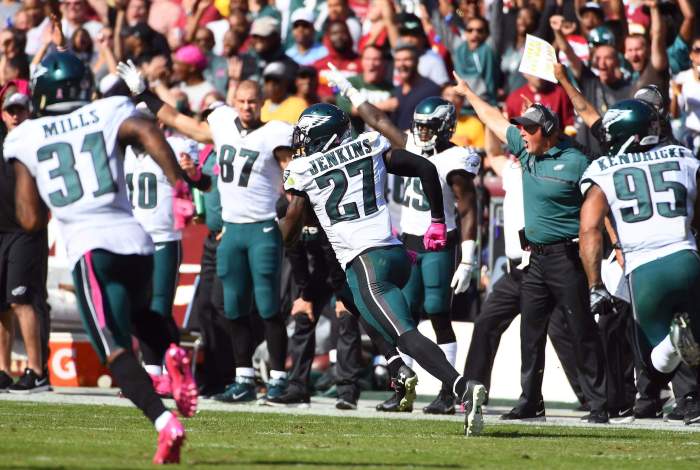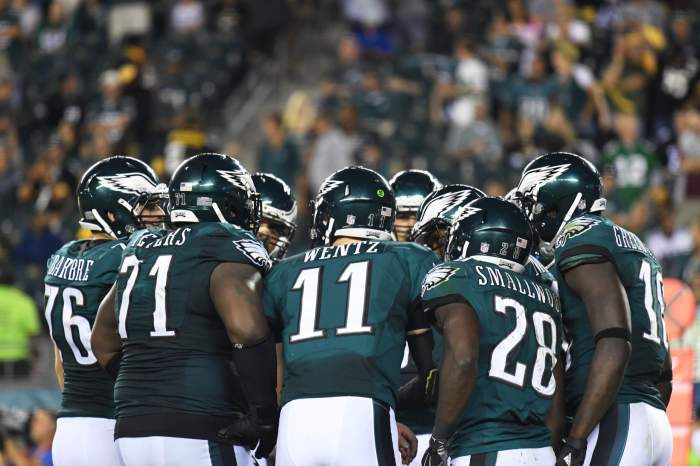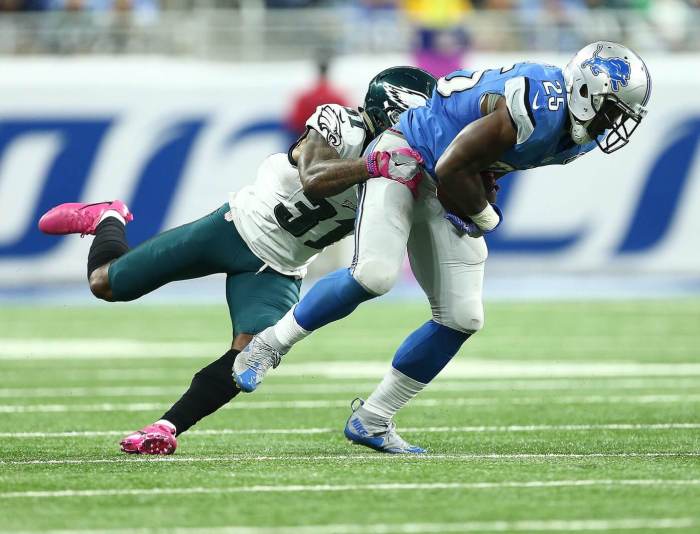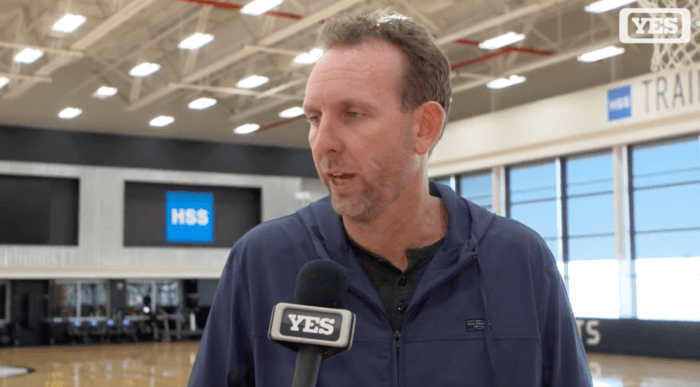We’re halfway through the month of July and football is just over the horizon. For the rest of the summer we will continue to analyse the Eagles’ NFC East opponents with true top and bottom line projections, full of arguable and opinion-based forecasts and rife with film study and statistics to back them up. The hope is that our position-by-position analysis will help make your own educated decisions on your “buddy’s” favourite team. Today we’re starting with the offence of perhaps our most perplexing opponent, the Washington Redskins. Let’s get started.
Quarterback
Last season was a mixed bag for the team in the nation’s capitol. They were able to hang tough against some difficult match-ups, even surprising a few perennial contenders, but got handed a deceptively punishing schedule. Their offence finished the season placing 16th in total yards (324.9 yards per game), with the 12th rated pass offence (234.4 yards per games) and the 28th ranked rushing attack (90.5 yards per game). Since today we will be focusing on the ‘Skins new quarterback here’s a mangle of mundane statistics that I’ll make reference to later. In brackets are the team’s league-wide rankings.
| Comp | Attempts | % | Yds/G | TDs | INTs | 20+ | 40+ | QBR |
| 347(14) | 540(18) | 64.3(8) | 234.4(12) | 27(9) | 13(16) | 59(5) | 11(11) | 93.9(11) |
If you haven’t heard, the long-lasting, tortuous contract sega with Kirk “Don’t-Call-Me-Kurt” Cousins has come to a close. After three above average seasons, Cousins was allowed to walk in free agency. Like it or not, the Redskins traded for their sparkly new QB, sending CB Kendall Fuller and a 2018 third-round pick to KC for 34-year-old Alex Smith.
In essence, the ‘Skins traded in their BMW for their mum’s old Volvo. Don’t take that as a knock on Mr. Smith, a Volvo is a damn good car: reliable, modest and will get you from point a to b without hiccups. That also isn’t meant to be a compliment to Cousins, as for whatever reason, the coaching staff never seemed content. The BMW for all its promise is an expensive and finicky vehicle. Since their rookie seasons it seems as if teams have been trying to replace the both of them. At its core, this move comes down to money. Washington gave Smith a contract worth approximately $23.5 million a year, whereas franchise tagging Cousins would have cost them $34 million in 2018. Realistically, both quarterbacks are very similar: highly accurate, smart decision makers with good arm strength and a quiet confidence. Below are their stats since 2015, when Cousins earned the starting position in Washington. While there is a major difference in record, I blame the discrepancy on the disparity in defence and rushing attack. Alex Smith is not asked to single-handedly win games the way Kirk Cousins is.
| 2015- | Record | Comp | Att | % | Yards | Yds/Att | TD | INT | QBR |
| Cousins | 24-23-1 | 1,132 | 1,689 | 67 | 13,176 | 7.0 | 81 | 36 | 97.5 |
| Smith | 31-15 | 976 | 1,464 | 67 | 11,030 | 6.9 | 61 | 20 | 97.2 |
If it seems as if both stat lines are eerily similar, you’re barking up the right tree. With Cousins there’s just more – more completions, more attempts, more yards, more touchdowns, more interceptions. In fact, herein lies one of the differences between the two signal callers. In each of the last three seasons, the Redskins have thrown more than 540 times. Smith has only thrown more than 505 times in a season twice: last season when he had 505 attempts and in 2013 when he threw 508 times. Coach Jay Gruden runs a West-Coast style, pass-heavy offence, and I personally don’t see him making many adjustments for the new QB. As the season went on last year, Smith, along with the entire Chiefs offence, saw a consistent drop off in efficiency and results, despite playing lesser competition. It will be interesting to see how he handles another season of 500+ passing attempts. Over his career he has played 156 games to Kirk Cousins’ 62. That being said, Smith enjoyed a career year with KC in 2017. I included his 2016 season statistics for comparison.
| Smith | Completions | Attempts | % | Yards | TD | INT | Yds/Att | QBR |
| 2016 | 328 | 489 | 67.1 | 3,502 | 15 | 8 | 7.0 | 91.2 |
| 2017 | 341 | 505 | 67.5 | 4,042* | 26* | 5 | 8.6* | 104.7* |
* Career best
Where Smith made the biggest improvement was on his deep ball. In NFL statistics, a deep ball is any pass that travels 20 yards or more. You’ll see below that this was not always one of the better facets of Smith’s game; in fact, it was often one of his biggest criticisms. In 2017 he almost totalled his career successes.
| Smith (20+ yards) | Yards | 30+ air yards | Touchdowns | Interceptions | Completion % |
| 2017 | 1,344 | 17 | 12 | 1 | 56.5 |
| 2012-2016 | 1,599 | 16 | 11 | 5 | – |
Having a jet-engine with legs at wide-out certainly helps his cause. KC receiver Tyreek Hill accounted for 628 yards (1st in the NFL ), 6 touchdowns (2nd) and a 131.4 quarterback rating (1st) when targeted on deep balls, to go along with a 54.2% catch rate (2nd). The Redskins simply don’t have someone on their roster that can account for that kind of production. Yes, this is including new acquisition Paul Richardson. Smith has proven capable of producing with meh receivers: a declining Jeremy Maclin, Albert Wilson, Chris Conley and an old Dwayne Bowe. However, even if the receiving corps is able to step up, evidence would point against Alex Smith repeating his 2017 deep ball numbers.
**GET FREE SHIPPING ON OFFICIAL EAGLES GEAR AHEAD OF THE NEW SEASON**
Per Jimmy Kempski of PhillyVoice, since 2007, 36 quarterbacks have thrown for over 1,000 deep ball yards in a season and not a single one of them has been able to replicate that success the following year. The average deep ball yards for these QBs in the following year was 878.9 yards. For Gruden’s offence to work, they don’t necessarily need to ride the deep passes, only to threaten it. This is one of the reasons they switched from Cousins to Smith. Brick Wall Blitz’s Deep Ball Project measures a quarterback’s deep ball efficiency on any throw 16 yards or more. After the 2017 season, Alex Smith ranked 6th on that list; Cousins placed 30th. You can view the full list at https://brickwallblitz.com/2018/03/28/the-2017-18-deep-ball-project/. This transition may have been lined with some hope and shortsightedness however, as Cousins and Smith have been relatively similar in terms of deep ball production since 2015.
| Comp | Att | % | Yds/Att | TD:INT | QBR | |
| Cousins | 81 | 198 | 40.9 | 14.54 | 2.63 | 106.8 |
| Smith | 62 | 149 | 41.6 | 15.56 | 3.75 | 111.2 |
The only marginal difference is the discrepancy in touchdown to interception ratio and quarterback rating. Neither of these QBs are incredibly talented deep passers, but in a what-have-you-done-for-me-lately league, Smith’s 2017 season gives him the upper-hand. Surprisingly, Washington wasn’t worried about acquiring another over-30 Andy Reid quarterback after what happened with Donovan McNabb. Other quarterbacks like AJ Feely and Kevin Kolb did not find success after leaving Reid’s system. I will say that personally, I believe Smith to be the more decisive passer of the two and a better all around decision maker. Cousins offers a slight bump in arm talent, but I don’t think he brings too much to the table that Smith cannot – besides youth.
The biggest question on everybody’s mind is: should Redskins front office should be concerned with Smith’s age? History says, well, marginally. Below is a chart of average adjusted net yards per pass of QBs 30 and over since 1970, thanks to Pro Football Reference. On average, 34 year-old quarterbacks see a significant decline begin which continues in their late 30’s. In Gruden’s dink-and-dunk high-percentage completion offence, yards per attempt is not the most compelling statistic, but it does offer some insight on deep-ball passing. At this point in his career, acquiring Smith seems to be a stop-gap solution. He may provide a few above average seasons, but ultimately, he is on the back nine of his career.
I mention this for two reasons. The first being, if the ‘Skins did bring in Smith to mentor a young talent, they haven’t made any indication of who that might be. Under owner Dan Snyder, who bought the team in 1999, the Redskins have only once drafted a quarterback in the top half of the first round. That pick was Robert Griffin III, and we all know how that panned out. They do have the young Kevin Hogan on the roster, but I highly doubt he is the answer for Washington. The second reason is, if the Redskins are to prolong Smith’s career, they will have to support him with a dangerous run game.
| Smith | Attempts | Yards | % | Touchdowns | Interceptions | Rush Yards | Yds/Rush |
| 2017* | 505 | 4,042 | 67.5 | 26 | 5 | 9th | 1st |
| 2016* | 489 | 3,502 | 67.1 | 15 | 8 | 15th | 16th |
| 2015 | 470 | 3,486 | 65.3 | 20 | 7 | 6th | 3rd |
| 2014 | 464 | 3,265 | 65.3 | 18 | 6 | 10th | 3rd |
| 2013* | 508 | 3,313 | 60.6 | 23 | 7 | 10th | 4th |
* Made Pro Bowl
In almost every year Smith was in Missouri, he was blessed with a top 10 rushing attack in either total yards or yards per rush. In the one specious season, you’ll notice a serious drop in touchdown to interception ratio. The Redskins 28th ranked rushing attack simply won’t cut it if they want the Alex Smith of 2017. Last season, KC ran play action on 24% of their pass plays, good for 6th in the league. Since 2015, Washington hasn’t cracked 20%. This was perhaps veiled by the fact that Kirk Cousins was the most efficient play action passer in 2017 with a 129.7 passer rating. That’s a pretty surprising statistic when you consider absolutely nobody respected the Redskins rushing attack last season. Later this week, when we dive into the Redskins’ run game, you’ll notice they haven’t actually been good since Jay Gruden took over. The Chiefs averaged about 28 more yards per game on the ground than the ‘Skins in 2017. This may point to Smith’s ability to put the offence in the right play at the line of scrimmage, but that’s difficult to prove without being in the huddle.
The run game is an area that Alex Smith might be able to create some results for himself. He managed 355 yards rushing last season, and has averaged more than 5.0 yards per carry in 5 different seasons. When he’s not picking up yards by his lonesome, he’s creating space to operate and keeping his head downfield looking for receivers. You’ll see below an example of each. Smith isn’t known to be the most agile QB, but his mobility is definitely an important facet of his game. In the first video at 2:26, the play breaks down and Smith runs for the first. In the second, at 4:48, you’ll see him escape the pressure and offload the ball to his safety valve underneath. The ability to make plays on the fly looks to be one of the areas the Redskins hope to improve in 2018. Bringing in Paul Richardson, who has experience playing with improvisational king Russell Wilson in Seattle, is further evidence of this.
This becomes an issue when Smith isn’t able to see a window to use his athleticism. One of the knocks against him is that he has a tendency to get “happy feet” when he sees pressure. He doesn’t always settle his feet in the pocket, looking to extend plays with his feet before he needs to, and therefore he isn’t in position when he decides to throw the ball. This can cause overthrows, under-throws, and miscues. To avoid the big interceptions, Smith can retreat into a shell, keeping his head down and taking unnecessary sacks. The video above with highlights versus Pittsburgh (at 3:21) is an example where he sees blitz, reads the coverage and sees his receiver open, but feels the pressure and panics instead taking an unneeded sack.
This would cause most to think that Smith might be a downgrade in relation to Cousins in terms of throws under pressure. The ability to stare down the blitz and make an accurate throw is something Cousins is lauded for. In reality, in a 2017 study measuring Defence Adjusted Value Over Average on throws under pressure, Football Outsiders found Alex Smith to be the better passer. Placing 18th, Smith only suffered a –100.0% drop in efficiency, whereas Cousins, who ranked 23rd had a –115.8% drop in value. In fact, last season Cousins threw an NFL-worst 8 interceptions while under pressure – Smith did not throw one.
The final criticism against Smith is that he often depends on his receivers to get him yards after the catch on third down. On 3rd down in 2017, Smith threw behind the line to gain on 41% of his throws and had a 50% completion rate when doing so. Play-makers such as Hill and tight end Travis Kelce help, but Smith has developed a considerable rapport with them in his seasons with the Chiefs. He will have to develop some chemistry with his new receivers in a hurry if he hopes to continue to depend on them on 3rd down, especially with superstar tight end Jordan Reed missing most of the off-season due to foot surgery.
Best Case: Alex Smith is the first quarterback in a decade to have two 1,000-yard deep ball seasons in a row – just breaking the mark in the last game of the season. The offence churns under Smith and takes advantage of a decline in interceptions and negative plays. Smith puts the team in the best play available more often than the last guy, and the run and pass attack benefit. Efficiency in the play action game continues under savvy Smith. The new Q provides an upgrade under duress – which might be necessary if Washington’s offensive line suffers through the injuries they did last season. Gruden meets his new quarterback halfway and the team finishes the season with around 500 pass attempts. There have already been multiple reports that the coach plans to tailor his offence to his new shot-caller. Chris Thompson and Jamison Crowder are the biggest beneficiaries of the new man under centre, but the whole interior offence purrs with Smith at the helm.
Worst Case: Smith is unable to keep up with the rigours of 540 pass attempts a season and shows signs of slowing down late in the season. Looking more like Alex Smith of old, he coasts to a 3,300-yard season and sees his interceptions go up slightly without a commanding run game. He is also unable to repeat his success in the deep passing game without his comrade Tyreek Hill. What hurts the most is that Kirk Cousins is lighting it up with the Vikings in Minnesota.
Mandatory Credit: Geoff Burke-USA TODAY Sports

